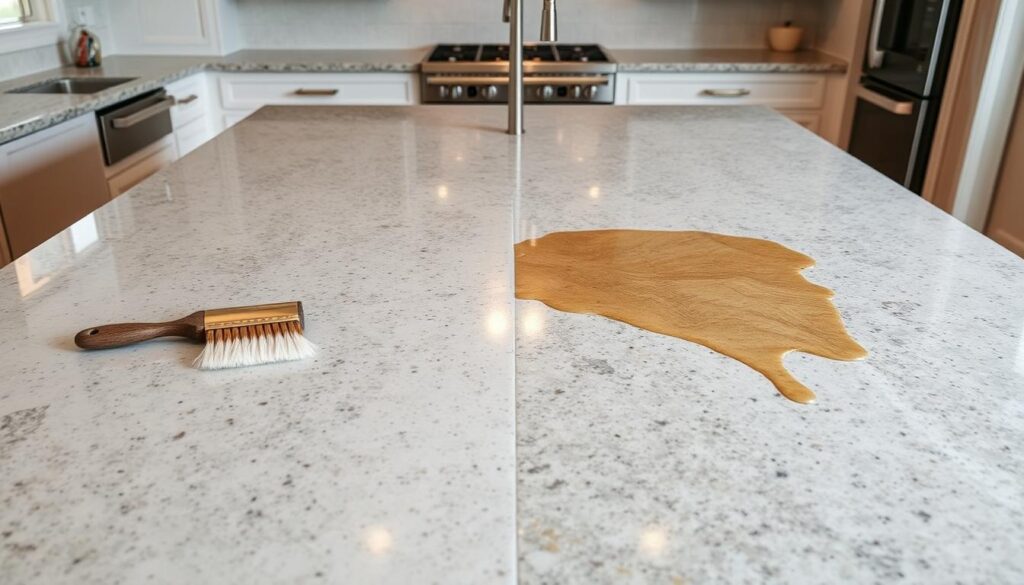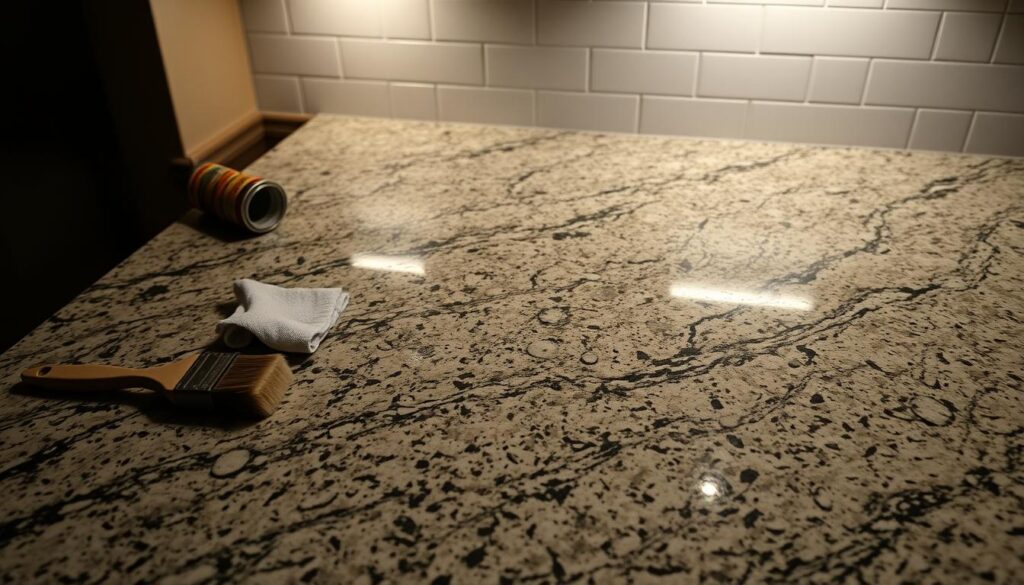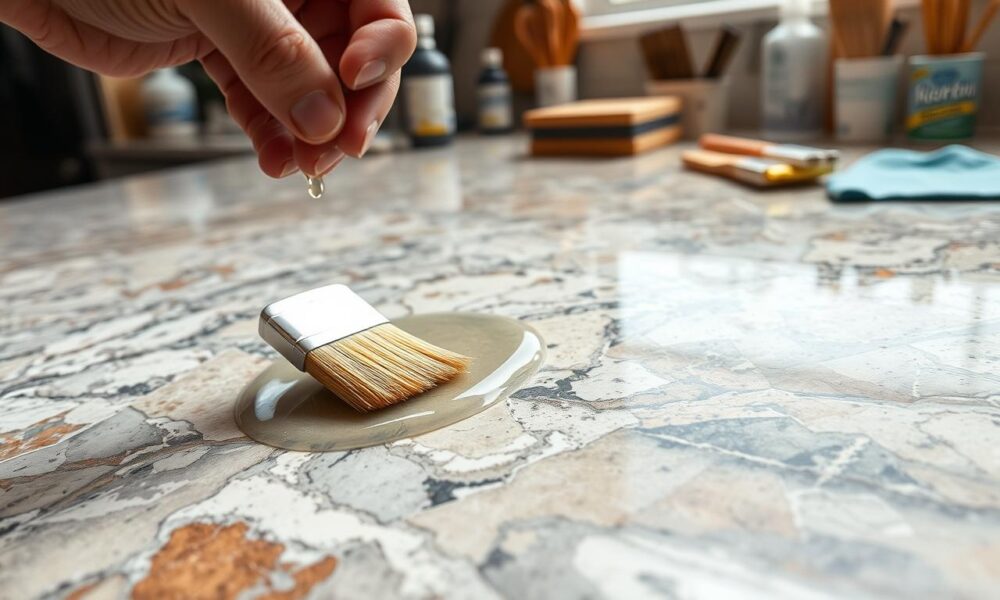The Do’s and Don’ts of Sealing Natural Stone Countertops
Natural stone surfaces bring timeless elegance to kitchens, but their beauty depends on proper care. Unlike synthetic materials, these porous surfaces absorb spills, oils, and cleaning agents, which can cause permanent stains or etching. A high-quality sealer acts as an invisible shield, blocking liquids from penetrating while preserving the stone’s natural texture.
Many newly installed countertops come with factory-applied protection, though this coating wears down over time. Homeowners must monitor their surfaces: water droplets absorbing quickly signal it’s time to reapply. Choosing the right product matters—dense stones like granite need less frequent treatment than porous marble.
Effective maintenance balances proactive steps with avoiding common mistakes. Using harsh cleaners or skipping resealing schedules can degrade surfaces prematurely. This guide outlines practical strategies to protect investments, from testing methods to application techniques that ensure lasting results.
Key Takeaways
- Porous surfaces require regular sealing to resist stains and water damage
- Sealants create a protective barrier without altering the stone’s appearance
- Resealing frequency varies by stone type and product durability
- Proper application techniques prevent streaks and ensure full coverage
- Neutral pH cleaners maintain sealant effectiveness between treatments
Understanding Natural Stone and Its Porous Nature
Natural materials like granite or marble transform kitchens into luxurious spaces, but their microscopic pores demand attention. These tiny openings form during geological processes, creating pathways for liquids and particles to penetrate surfaces. Without protection, spills can seep deep into the stone, leading to discoloration or bacterial growth.
Why Natural Stone is Porous
Formed under intense heat and pressure, natural stone develops a network of pores. Marble absorbs liquids faster than dense granite due to its calcite composition. A simple water test reveals porosity: droplets disappearing within 5 minutes signal high absorption rates. Regular monitoring helps homeowners address vulnerabilities before stains set.
Comparing Stone Countertop Properties
| Material | Porosity Level | Resealing Frequency | Common Uses |
|---|---|---|---|
| Granite | Low-Moderate | Every 2-3 Years | Kitchen Islands |
| Marble | High | Annually | Bathroom Vanities |
| Quartzite | Moderate | Every 1-2 Years | Outdoor Kitchens |
Light-colored surfaces often show stains more visibly, requiring pH-neutral cleaners for daily maintenance. Professionals recommend avoiding vinegar-based solutions, which degrade protective sealants over time. Proper care preserves both functionality and aesthetic appeal.
Key Benefits of Sealing Your Stone Surfaces
Investing in premium stone surfaces demands proactive protection. Sealing creates an invisible defense system that combats daily wear while preserving material integrity. Let’s explore how this process safeguards surfaces against common threats.
Stopping Stains Before They Start
Unsealed surfaces absorb liquids like sponges. Red wine spills or coffee drips penetrate pores within minutes, leaving permanent marks. Quality sealants block absorption, giving homeowners time to wipe accidents without panic. For example, sealed marble resists berry juice stains for hours versus seconds on untreated surfaces.
Extending Surface Lifespan
Impregnating sealers reinforce stone from within, reducing cracks and etching. A study by the Natural Stone Institute found sealed granite lasts 50% longer in high-traffic kitchens. This protection minimizes costly repairs—like polishing out water rings or replacing etched zones.
- Blocks oil-based stains from salad dressings or cosmetics
- Prevents bacterial growth in bathroom vanities
- Maintains original gloss despite daily cleaning
Routine maintenance becomes simpler with effective sealing. pH-neutral cleaners won’t degrade the barrier, ensuring consistent care between reapplications. Test annually by sprinkling water—if droplets bead up, your countertops remain shielded.
The Do’s and Don’ts of Sealing Natural Stone Countertops
Proper sealing techniques separate pristine countertops from damaged surfaces. Strategic application methods preserve material integrity while avoiding common pitfalls that create hazy finishes or uneven protection.

Essential Do’s for a Perfect Seal
Start with thorough surface preparation. Clean stone surfaces using pH-neutral cleaners and let them dry completely. Follow these critical steps:
- Test sealant compatibility in hidden areas before full application
- Use microfiber cloths or foam brushes for even distribution
- Apply thin layers using overlapping circular motions
Always follow manufacturer instructions for dwell time. Work in small sections to maintain control during the process. Wipe excess product immediately to prevent residue buildup.
Common Don’ts to Avoid Damage
Over-application remains the most frequent error. Avoid these damaging practices:
- Never pour sealer directly onto countertops
- Don’t use abrasive tools like steel wool or stiff brushes
- Avoid sealing in humid conditions or extreme temperatures
| Action | Reason | Recommended Tools |
|---|---|---|
| Thin Sealant Layers | Prevents Slick Finish | Foam Applicator |
| Immediate Wipe-off | Avoids Residue | Microfiber Cloth |
| Sectional Application | Ensures Full Coverage | Painters Tape |
Pro Tip: Perform water tests annually. If droplets absorb within 10 minutes, schedule resealing. Balance protection needs with surface texture – glossy finishes require thinner coats than honed materials.
Choosing the Right Sealant: Non-Toxic vs. Solvent-Based
Selecting the ideal protective coating for mineral surfaces requires balancing safety and performance. Stone composition, household needs, and environmental impact all influence this decision. Two primary options dominate the market: water-based formulas and solvent-driven solutions.
Benefits of Non-Toxic, Water-Based Sealers
Eco-conscious homeowners often favor water-based sealers for their low VOC levels and minimal odor. These products, like Tenax Proseal, penetrate surfaces gently while allowing moisture vapor exchange. Ideal for softer materials such as marble or limestone, they reduce yellowing risks on light-colored stones.
Key advantages include:
- Safer indoor air quality during application
- Faster drying times (30-60 minutes)
- Easy cleanup with soap and water
However, these sealants may require annual reapplication in high-use kitchens. Industry expert David Akenhead notes: “Water-based formulas excel in bathrooms where ventilation is limited, but granite often demands stronger protection.”
When to Use Solvent-Based Sealants
Dense stones like granite benefit from solvent-based products’ deeper penetration. These solutions carry active ingredients further into pores, creating durable barriers against oil stains. Brands like StoneTech BulletProof use this technology for outdoor kitchens and heavily used islands.
Consider these factors:
- Higher VOC content necessitates proper ventilation
- Longer curing periods (up to 48 hours)
- Superior resistance to acidic spills
| Feature | Water-Based | Solvent-Based |
|---|---|---|
| Penetration Depth | 0.5-1mm | 2-3mm |
| Drying Time | 1 Hour | 24 Hours |
| VOC Content | 20-40% |
Ryan Burden, a restoration specialist, advises: “Always check manufacturer guidelines—some non-toxic options work surprisingly well on quartzite if reapplied quarterly.” Match the product’s strength to your stone’s porosity and your household’s chemical exposure.
Step-by-Step Guide to Sealing Your Countertops
Achieving professional-grade protection for mineral surfaces requires methodical execution. This process combines precise preparation with strategic product application to create durable barriers against stains and spills.
Preparation: Cleaning and Drying the Surface
Begin by clearing the workspace. Remove appliances and decor from the countertop. Mix 1 teaspoon dish soap with 2 tablespoons rubbing alcohol in a spray bottle. Thoroughly mist the surface, then wipe with a microfiber cloth to eliminate grease or residue.
Allow 24 hours for complete drying. Moisture trapped beneath products prevents proper adhesion. Cover adjacent cabinets and floors with plastic sheeting to protect the area from accidental drips.
Application Techniques and Best Practices
Test the cleaners-compatible sealant in hidden spots first. Pour a small amount onto a foam brush or lint-free towel. Work in 4×4 ft sections using circular motions, ensuring even coverage without pooling.
Let the formula penetrate for 5-10 minutes per manufacturer guidelines. Buff vigorously with a dry cloth to remove excess—streaks indicate improper removal. Repeat across the entire surface, maintaining wet edges between sections.
| Tool | Best For | Drying Time |
|---|---|---|
| Foam Brush | Small Areas | 30 Minutes |
| Microfiber Pad | Large Surfaces | 45 Minutes |
| Lint-Free Cloth | Curved Edges | 20 Minutes |
Allow 48 hours curing before using the countertop. Stone restoration expert Lena Torres advises: “Never rush the final buffing stage—unremoved residue attracts dirt and compromises protection.” Annual water tests will confirm when resealing becomes necessary.
Common Mistakes in Sealing Stone Countertops
Even careful homeowners can undermine their stone surfaces through preventable sealing errors. These missteps often stem from misinformation or rushed applications, leading to compromised protection and aesthetic flaws.

Over-Sealing and Uneven Application
Applying multiple coats without proper drying creates a tacky residue that traps dust. Thick layers dry unevenly, forming dark spots where excess product pools. A 2023 Marble Institute study found 68% of DIY sealing failures involved improper wipe-off techniques.
Key indicators of over-sealing:
- Cloudy or streaked appearance under light
- Resistance to water beading despite recent treatment
- Slick texture that feels plastic-like
Polishing Without Proper Sealing
Polishing unsealed surfaces accelerates wear by exposing pores to abrasive compounds. This creates a chalky finish as polishing powders mix with stone minerals. Restoration specialist Mara Klein warns: “Always seal before polishing—reversing this sequence removes protective barriers and etches the surface.”
| Mistake | Result | Fix |
|---|---|---|
| Ignoring hidden areas | Uneven protection | Move appliances during application |
| Using vinegar cleaners | Sealant breakdown | Switch to pH-neutral formulas |
| Skipping water tests | Untimely resealing | Check absorption monthly |
Conduct regular inspections using the water bead method. Place droplets in high-use zones—if they disappear within 5 minutes, reseal those countertop sections immediately. Address localized issues before they compromise the entire surface.
Maintenance Tips for Long-Lasting Countertop Protection
Preserving mineral surfaces requires consistent care paired with smart monitoring. Daily habits and periodic checks prevent costly repairs while maintaining visual appeal. Follow these strategies to balance practicality with protection.
Effective Routine Cleaning Methods
Establish a daily wipe-down using pH-neutral formulas. Mix 1 teaspoon mild dish soap with warm water in a spray bottle. Blot spills immediately with microfiber cloths—rubbing spreads liquids into pores. Avoid abrasive pads or citrus-based cleaners that degrade sealer effectiveness.
- Use trivets under hot pans to prevent heat damage
- Place coasters under acidic beverages like wine or coffee
- Clean cutting boards after use to avoid cross-contamination
| Cleaning Agent | Tool | Frequency |
|---|---|---|
| Stone-specific cleaner | Microfiber cloth | Daily |
| Rubbing alcohol solution | Soft sponge | Weekly |
| Sealer-safe polish | Lint-free towel | Monthly |
When and How to Reseal Your Stone
Conduct water tests every 6 months. Drop liquid on high-traffic zones—if dark spots form within 10 minutes, schedule resealing. Busy kitchens typically need annual treatments, while bathroom vanities last 2-3 years between applications.
Restoration expert Clara Merton advises: “Always clean surfaces thoroughly before applying sealer. Residual grease creates uneven barriers that accelerate wear.” Use painter’s tape to protect adjacent areas and apply products in temperature-controlled rooms.
“Test multiple zones—edges absorb faster than flat surfaces. Address weaknesses before they compromise entire countertops.”
Expert Advice and Industry Insights
Industry leaders emphasize precision when maintaining mineral surfaces. Block Renovation’s David Akenhead stresses: “Sealing isn’t a guessing game—it’s science.” Proper execution preserves material integrity while avoiding costly errors.
What Professionals Recommend
Countertop Specialty’s Ryan Burden advises starting with surface analysis. Test absorption rates using the water bead method—droplets lingering over 10 minutes indicate sufficient protection. For high-traffic kitchen zones, experts suggest resealing every 6-12 months.
Key steps endorsed by professionals:
- Use pH-neutral tools for pre-cleaning to avoid chemical reactions
- Apply impregnating sealers in 70°F environments for optimal penetration
- Inspect edges and corners—common weak spots needing extra attention
| Professional Tip | DIY Mistake | Impact |
|---|---|---|
| 24-hour drying time | Immediate use after sealing | Reduced adhesion |
| Quarterly water tests | Annual inspections only | Untreated stains |
| Microfiber buffing | Paper towel residue | Streaked finish |
For complex projects, consult the detailed guidelines from stone care associations. Akenhead notes: “Spend 15 extra minutes testing products on samples—it prevents disasters.” This process ensures compatibility with unique stone surfaces.
Conclusion
Proper maintenance transforms stone surfaces from vulnerable to protected investments. Following tested strategies ensures lasting beauty and functionality for countertops, whether in busy kitchens or elegant bathrooms. Key practices like using pH-neutral care products, avoiding abrasive tools, and performing annual water tests form the foundation of effective upkeep.
Sealing remains non-negotiable for preserving porous materials. Selecting compatible stone sealants and applying them with microfiber towels prevents uneven finishes. Remember: thin layers outperform thick coatings, and immediate spill cleanup maintains the barrier’s integrity.
Homeowners should schedule resealing every 1-3 years, adjusting based on usage and stone type. Focus on high-traffic areas like sink surrounds, where protection degrades fastest. Consistent routines—paired with professional-grade products—yield surfaces that withstand daily demands while retaining their natural allure.
Start today: inspect your countertop, conduct a water bead check, and plan your next sealing session. With disciplined care, these surfaces will remain stunning centerpieces for decades, blending practicality with timeless elegance.


